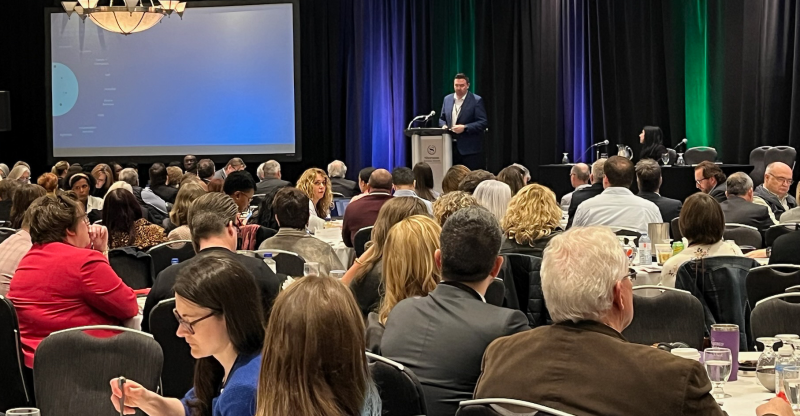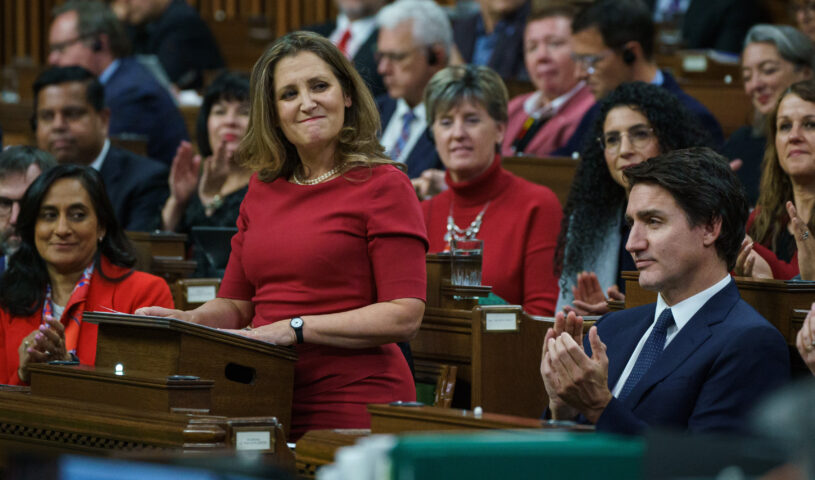Striving for answers in Ontario’s homelessness crisis
 The Association of Municipalities of Ontario invited elected officials, municipal staff, and social services partners to its Ending Homelessness Symposium, held May 3-4 in Toronto.
The Association of Municipalities of Ontario invited elected officials, municipal staff, and social services partners to its Ending Homelessness Symposium, held May 3-4 in Toronto.
Homelessness has reached disastrous proportions in Ontario. Many people – including Parry Sound Mayor Jamie McGarvey – have described the situation as a crisis. This isn’t rhetoric, as there are statistics backing up this perspective.
In fact, one recent estimate states homelessness across the country has doubled over the past three years. But McGarvey has recently heard the situation described in a simpler context.
McGarvey recently joined hundreds of elected officials, municipal staffers, and sector partners at a summit on homelessness. Put on by the Association of Municipalities of Ontario (AMO), the Ending Homelessness Symposium took place in Toronto, May 3-4.
While at the conference, McGarvey heard a description of homelessness he said puts the situation into the proper light.
“I really loved the comment from one the speakers on the first day … she said, ‘I feel like I’ve been stuck on a roundabout and can’t get off,’” McGarvey said. “That’s so true. But what I’m hoping is that we’ve created an exit to a better place.”
Municipalities on the Front Lines
The two-day event offered perspectives on the root causes of homelessness. These causes include obstacles such as income insecurity, an inadequate supply of affordable housing, insufficient responses to mental health and addiction challenges, and the policy responses required to deal with them.
McGarvey knows a great deal about the role municipalities play in the fight against homelessness. Not only is he the mayor of Parry Sound, Ont., but he is also the past president of AMO and has been chairing the association’s housing and homelessness task force for several years.
“Municipalities are the front line. So, we’re dealing with whatever situation on a day-to-day basis. We felt it was extremely important that we gather all the people into one place that are dealing with homelessness issues and have that conversation,” McGarvey said. “Everybody that was there had an opportunity to say something. If they wanted to rant – if they wanted to share what’s on their mind – we wanted to hear it. And we heard it. It was good.”
McGarvey lauded the symposium for varied collective backgrounds in the room. In particular, the symposium invited representatives from the province, including members from Municipal Affairs and Housing. There were representatives from the mental health sector, housing organizations, Indigenous leaders, and organizations working to help First Nations people.
McGarvey said the symposium provides attendees the opportunity to hear from people that are doing different things and try to move that forward. That data from those conversations will be shared with organizations, agencies, and governments to further future conversations and drive new action.
“To have everybody into a room, which I say was packed – to share everybody’s stories and situations – I think was a collective wonderful thing,” McGarvey said. “Maybe I’m idealistic, but I really believe that if we can come together in the right place, with the right frame of mind and the willingness to do it, that we can do it. We could actually do something.”
Lived Experience is Key
Brian Marks shares McGarvey’s careful optimism. Marks is CAO for the Cochrane District Social Services Administration Board. Marks also lauded the symposium organizers. He was quick to applaud how the event was important “from two practical perspectives.”
For one, Marks said the homelessness crisis has evolved to the point where it is incumbent upon an association that represents 444 municipalities to put the issue at the top of their priority list. This is especially true, he added, after the last municipal election. After all, he suspects the majority of municipal politicians ran with housing and homelessness at, or near, the top of their platforms.
But then the second practical piece, Marks said, harkens back to McGarvey’s point about the attendees in the room. Marks said he had never seen this number of elected municipal officials and administrators brought together in one room, on this topic, in his 24 years as part of social services sector.
As for his own participation, Marks said he felt he had to take advantage of the opportunity. And he did, relishing the chance to speak with not only the political decision makers in the room, but also to municipal staffers. But that said, he was quick to add he wasn’t all that happy to be there, either.
“Want is a strong word. I mean, I don’t know that anybody wants to be a part of this. The level of futility that comes with trying to address homelessness issues is significant,” Marks said. “But I had the privilege to be able to speak and outline a few key points when it comes to income security and case management. So, it was a good venue for that.”
Marks provided insights from his two decades of work in social services. He was joined by many other sector professionals, but perhaps more importantly, people with lived experience of homelessness took part as well.
These insights were important, Marks said, particularly for many of the elected officials in the room. For many elected officials, homelessness can seem like a daunting conversation. And of course it is. But in his experience, often when elected officials don’t know what is happening in the sector, they assume there is no plan in place. Marks was quick to say this isn’t the case.
The problem is that when it comes to ending or serving homelessness the plan changes almost daily. Marks offered an example from Timmins, Ont. Ten years ago, he said, nobody would’ve imagined people living on the streets in January and February when it’s -30 C. Unfortunately, that’s the reality today.
“Lived experience – it’s critical. It’s also swallowing your pride and acknowledging that you’d need to go to the experts, and those are the people with the lived experience. It’s having them involved in the solution moving forward so that they can be an asset for their peers,” Marks said. “There were people in the room with lived experience. It added much valuable input from them, to be able to provide perspective, not only for the administrators, which is needed, but definitely for the elected officials.”
Common Causes, Innovative Solutions
AMO has been very focused on the issue of homelessness for the past year. It’s a critical priority for almost many members across the province, according to Lindsay Jones. Jones is AMO’s Director of Policy and Government Relations.
Jones agrees with the perspective that homelessness has reached crisis levels. People see that reality, she said, from a social perspective, an economic perspective, and a health perspective. And it’s an area where the solution requires collaboration across many different partners.
This was the rationale for moving forward with the symposium. Jones said the goal of the event was to support AMO members in “trying to wrap their heads around the root causes of the issue.” It was also designed to highlight some of the innovative solutions that different municipalities and groups across the province have already put into play.
Jones described the symposium as “both an educational piece and a kind of coming together and generating ideas.” But she added it was also to highlight that homelessness is a problem, not only in big cities, but in communities across the province.
Given the scope of the crisis, it would be easy to question how much could be accomplished in two days. But, as it turns out, Jones said the momentum spinning out of the symposium provided a sense that the tide is starting to turn in this fight.
“You could feel the energy in the room. Trying to make progress on these really challenging issues is hard,” Jones said. “Coming together, to be able to see that everybody across the province is still very much kind of committed to making progress – that there is progress to be made, that it’s not an impossible task, and that folks aren’t in it alone. I think was something that really came out of the discussion.”
Vision for the Future
McGarvey was also positive about what the symposium accomplished. One achievement, McGarvey said, was having AMO reach out to the right people and bring them together in one room to have the conversation. But McGarvey also lauded the symposium for putting participants on a path forward. The plan is for AMO to compile the material gathered at the symposium, look at solutions, and determine a vision for defeating the crisis.
“Everybody has a part to play in this. The understanding was that we all have to play that part and we all have to act on it,” McGarvey said. “We’ve got these very unique solutions that people are experimenting with in other municipalities. If you’d listen to this package, if you read this package, we can all move forward to a better place.”
For Marks, it is somewhat of a “loaded question” to attempt to quantify the chances of success in the homelessness crisis. After all, one of the larger challenges, he said, is that he believes there’s enough money in the system to address homelessness. The larger issue is how the public and private sector choose to spend those dollars over the course of a four-year election cycle.
He is also quick to add that even if those resources are appropriately directed, and if education programs and mental health and addiction services were in place, there remains a significant hurdle to overcome. Marks said if society doesn’t acknowledge Truth and Reconciliation and the Calls to Action, and appropriately apply a cultural lens, homelessness will continue.
Marks also understands the futility that often rears its head in the housing fight. After all, an organization can do everything right for someone only to have them undermine those very same supportive efforts. Whether it’s a mental health or addictions issue, or some other personal obstacle, it is far from unusual for someone to find themselves right back on the street. And this cycle can repeat itself many times over. But he also said the solution to that struggle remains clear.
“There is no one right answer, but there’s absolutely one wrong answer, and that is to stop trying. And if you do anything other than quitting, it’s a step in the right direction,” Marks said. “It may not be the 99th time that you get this person to an ER, to access a safe bed, or a detox bed, it may be the 110th time. But these are the things that we have to face in homelessness, and in particular, looking upstream to avoid people having to get into those situations in the first place.” MW
✯ Municipal World Executive and Essentials Plus Members: You might also be interested in Sean’s other article: Searching for the missing middle housing solution.
Sean Meyer is Senior Editor for Municipal World.
Related resource materials:



